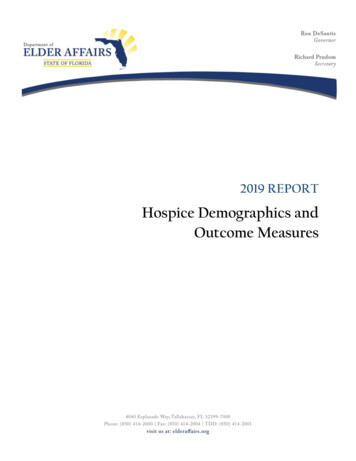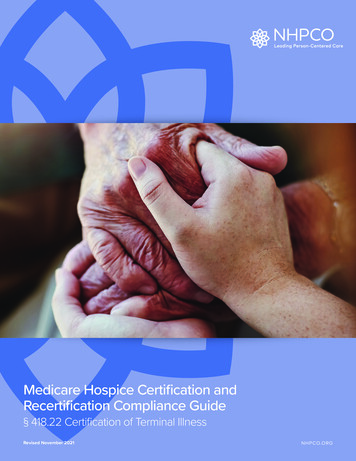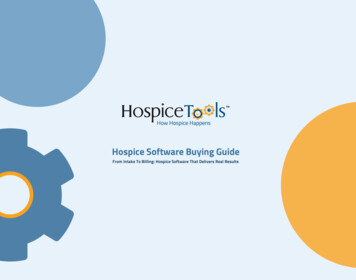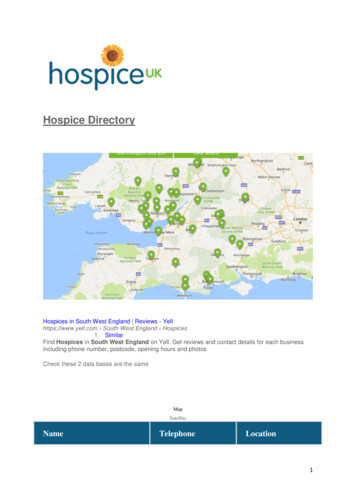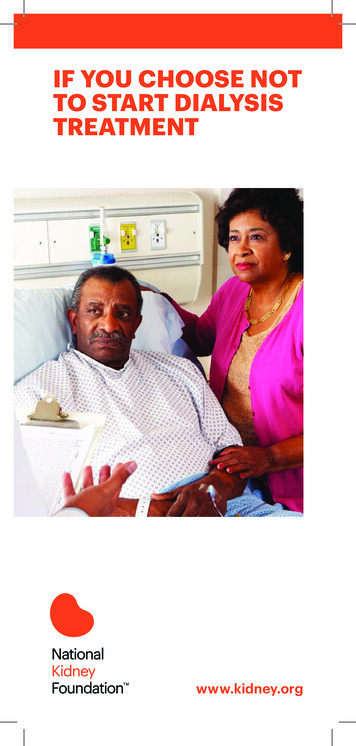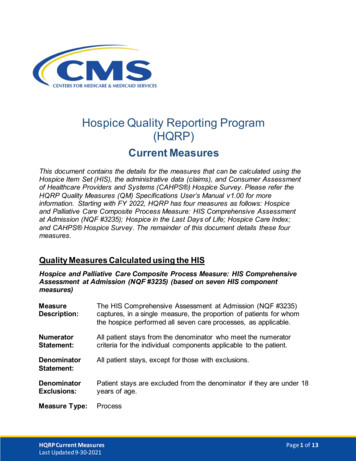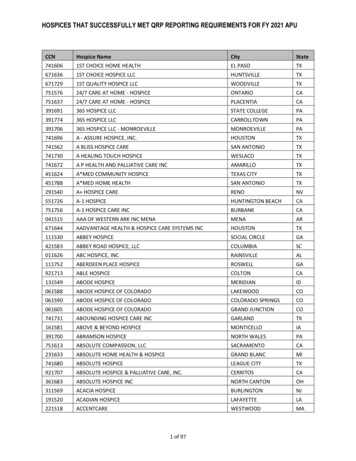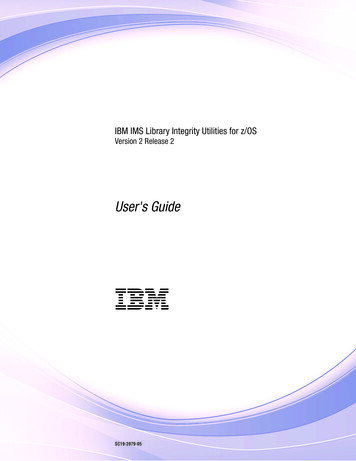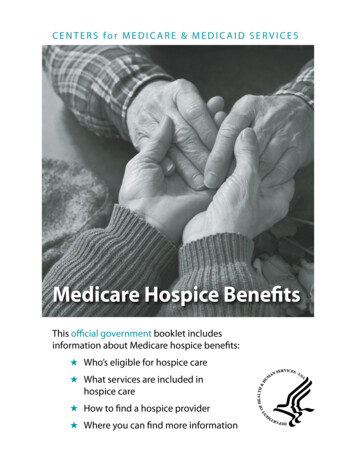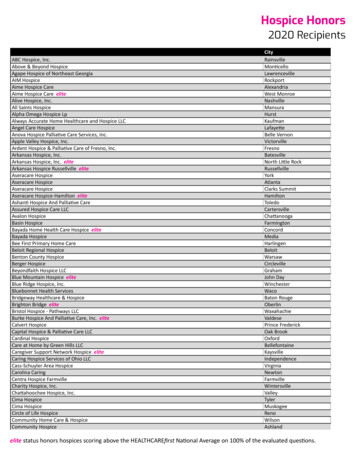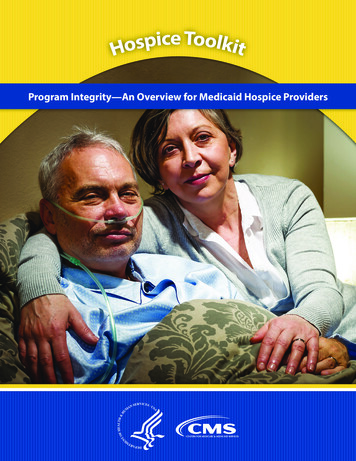
Transcription
Program Integrity—An Overview for Medicaid Hospice Providers
Content SummaryThis booklet discusses the Medicaid hospice benefit and the importance of provider documentationto support medical necessity and proper level of care; provides examples of fraud, waste, andabuse; reviews new practices to improve communication, documentation, and quality of care;and discusses what hospice providers and other stakeholders can do to help reduce improperpayments and improve the services offered. Finally, additional resources are listed in the bookletfor providers to understand anti-fraud efforts and the training they should provide to their staff.Contact information is provided to report potential fraud.2
IntroductionThe Centers for Medicare & Medicaid Services (CMS), Centerfor Program Integrity (CPI), and the States are providingeducational resources to hospice providers and other stakeholdersto enhance awareness of the Medicaid hospice benefit and toengage providers in efforts to prevent fraud, waste, and abuse inthe Medicaid program.CMS uses two comprehensive strategies to protect the integrityof Medicaid. The first strategy is the Medicaid IntegrityProgram (MIP) established under section 1936 of the SocialSecurity Act (SSA), which gives CMS two broad responsibilities:1. Effectively assist and support the efforts of the States tocombat Medicaid provider fraud and abuse; and2. Review Medicaid provider activities, audit claims,identify overpayments, and educate providers and otherson Medicaid program integrity issues.[1]The second strategy was established by Executive Order 13520which requires assurances that major programs administered bythe Federal government intensify efforts to eliminate paymenterror, waste, fraud, and abuse in high risk or vulnerable areas.[2]Definition of Hospice CareThe SSA (“the Act” in this paragraph) defines hospice care as a “comprehensive set of services describedin [Section] 1861(dd)(1) of the Act, identified and coordinated by an interdisciplinary group to provide for thephysical, psychosocial, spiritual, and emotional needs of a terminally ill patient and/or family members, asdelineated in a specific patient plan of care.”[3, 4, 5] Under the authority of sections 1905(a)(18) and (o) of theAct, hospice benefits are services provided by a Medicaid-participating hospice program. The hospice programis a public or private organization that meets the requirements as defined under Section 1861(dd)(2) of the Act.The hospice provider must have an interdisciplinary group of personnel that includes at least one physician, oneregistered professional nurse, and one social worker that provides or supervises the provision of hospice careand services and that establishes policies governing the provision of such care and services.[6] The participant’sattending physician, along with the hospice interdisciplinary team, establishes and periodically reviews theparticipant’s care plan.[7, 8]Palliative care can help manage the pain and symptoms of illness, whether the illness is terminal or not. Palliativecare is distinct from curative care, which seeks a cure for a disease or medical condition. Palliative care can gohand-in-hand with hospice care for the patient who has chosen to end or forgo curative treatment, unless he or sheis 21 years of age or younger.[9] However, a patient does not have to be in hospice or at the end of life to receivepalliative care.Program Integrity—An Overview for Medicaid Hospice Providers3
Results of Hospice AuditsRecent State and U.S. Department of Health and Human Services, Office of Inspector General (HHS-OIG) auditsof Medicaid hospice providers uncovered a trend of overpayments made for claims submitted for hospice servicesprovided to Medicaid participants that lacked documentation supporting life expectancy of 6 months or less.Specifically, claims were denied because: Medical records did not support a terminal illness with a life expectancy of 6 months or less, or did notsupport patient status generally;[10, 11]Certification was not provided in a timely manner;[12, 13]Hospice employees were not properly vetted or licensed;[14, 15, 16]Documentation supported long-term or custodial care rather than hospice care;[17, 18] andThe principal hospice diagnoses on the claims were adult failure to thrive, dementia, and debility.[19, 20]Federal regulations for the Medicaid hospice benefit defer to Medicare hospice benefit regulations for definitionsof hospice care and a hospice program.[21] Therefore, Medicaid hospice programs often follow Medicare rulesand regulations for determination of eligibility and benefits provided. CMS issued final rules on August 7, 2013,that specifically addressed the Medicare diagnoses related to eligibility for the hospice benefit. The rules clarifythat nonspecific symptom diagnoses, such as adult failure to thrive, dementia, and debility, may no longer beconsidered the principal diagnosis for determining eligibility under the Medicare hospice program. Nonspecificsymptom diagnoses listed as principal diagnoses will be identified as questionable encounters and will be returnedto the provider for a more definitive principal diagnosis.[22] Check with your State Medicaid agency (SMA)to see if this rule applies in your State.This booklet provides an overview of the Medicaid hospice benefit; examples of fraud, waste, and abuse; newpractices for improvement in communication, documentation, and quality of care; and actions hospice providersand other stakeholders can take to help reduce improper payments and to improve the services offered.4
Medicaid Hospice Benefit OverviewThe Medicaid programs in almost all 50 States and the District of Columbia currently designate hospice as acovered benefit.[23] However, hospice service is an optional benefit that allows each State some flexibility as longas the hospice benefit complies with minimum Federal requirements.[24] For example, prior authorization maybe required for specific procedures or services; life expectancy requirements may be longer; a copayment may berequired; or the benefit may only be available to specific eligibility groups.[25]Upon election of the hospice benefit, treatment to cure the terminal illness usually ceases. An exception is providedunder Section 2302 of the Affordable Care Act, which allows participants younger than 21 who are eligiblefor the Children’s Health Insurance Program (CHIP) and Medicaid to enroll in a hospice program and receiveMedicaid-covered services to treat their terminal illness.[26, 27]Services covered under hospice must be provided by a participating hospice program that meets Medicarecertification requirements and has a valid provider agreement. Hospice benefits covered under Medicaid andMedicare are often very similar. Providers should check their SMA provider manual for specific definitions,applicable Medicare local coverage determinations (LCDs), and benefits available.The benefits listed below are examples of the minimum services available through hospice care: Physician services furnished by hospice-employed physicians and nurse practitioners, or by other physiciansunder arrangement with the hospice;Nursing care;Medical equipment;Medical supplies;Drugs for symptom control and pain relief;Hospice aide and homemaker services;Physical therapy;Occupational therapy;Speech-language pathology services;Social worker services;Dietary counseling; andShort-term inpatient care for pain control and symptom management, and for respite care.[28]Hospice services are designed to be provided in the participant’s home, but for purposes of the Medicaid hospicebenefit, a nursing facility may be considered a participant’s home.[29] In these cases, an additional paymentis made to the hospice for nursing facility services that covers both room and board and ancillary services.Contact your SMA for other facilities that may be considered a Medicaid participant’s home under the Medicaidhospice benefit.Medicaid hospice benefits can also include anything else needed to manage terminal illness and related conditionsnormally covered by Medicare. Nursing care, physicians’ services, medical social services, and counseling arecore hospice services and must routinely be provided directly by hospice employees. Supplemental services maybe contracted for during periods of peak patient loads and to obtain physician specialty services.[30]Program Integrity—An Overview for Medicaid Hospice Providers5
EligibilityEligibility for hospice care under Medicaid requires physician certification that the participant is terminallyill.[31] Each State’s definition of “terminal illness” includes a medical prognosis with a limited life expectancy;however, the length of the life expectancy may differ from State to State. Some States, including Kentucky[32]and Texas,[33] use the Medicare definition of “terminal illness” as a medical prognosis with a life expectancy of6 months or less if the illness runs its normal course.[34, 35] States have the option to provide longer lifeexpectancy criteria for determining hospice eligibility through an amendment to their Medicaid State plan.For example, the State of New York requires a prognosis of life expectancy of 12 months or less for hospiceeligibility.[36] As a Medicaid provider, you are responsible for knowing the waivers to eligibility requirementsfor your State. The terminal prognosis also must be supported by clinical information and other documentation inthe medical record.[37, 38]Participants must elect hospice benefits by completing an election of hospice benefits form with a particularhospice.[39] The election form must contain: Identification of the particular hospice that will provide care; Acknowledgement that certain Medicare and Medicaid services are waived by the election;[40] 6The participant’s or representative’s acknowledgement that he or she has been given a full understandingof the palliative rather than curative nature of hospice care, as it relates to the participant’s terminal illness;The effective date of the election, which may be the first day of hospice care or a later date, but may be noearlier than the date of the election statement;The name of the participant’s designated attending physician (if any). Information identifying the attendingphysician recorded on the election statement should provide enough detail so that it is clear which physicianor nurse practitioner was designated as the attending physician. This information can include, but is notlimited to, the attending physician’s name and National Provider Identifier (NPI).The participant’s acknowledgment that the designated attending physician was the participant’s orrepresentative’s choice; andThe signature of the participant or representative.[41]
Election of BenefitsThe election of benefits stays in effect as long as the participant remains in hospice, does not revoke the election,and is not discharged from hospice for other reasons.[42] Reasons for discharge may include: the participant isno longer considered terminally ill, the participant transfers to another hospice, the participant moves out of thehospice service area, or the participant is not receiving the required or expected care from the hospice provider.A participant may also be discharged “for cause” if the hospice determines the participant’s behavior is disruptiveor otherwise prevents effective delivery of care and attempts to resolve the situation have not been successful.A participant may not be discharged simply for using necessary hospice services.[43]States are required to offer at least 210 days of hospice coverage that may be subdivided into two or more timeperiods, typically two 90-day periods and a 30-day period.[44] The Medicare benefit is divided into two 90-dayperiods and an unlimited number of 60-day periods.[45] Although States are not required to adopt Medicareguidelines for benefit periods, many do for coordination of care. Ultimately, duration for Medicaid coverage is upto each State, so check with your SMA for policies about benefit periods for hospice coverage.After an eligible participant elects hospice care, the hospice must receive physician certification within 2 daysof the written or verbal initiation of hospice care. If the certification is given verbally, the written certificationmust be completed within 8 days.[46] Benefits may continue for each subsequent period if the participant doesnot revoke the benefit and if the required certifications are made, and as long as the hospice follows each State’spolicies.[47] Recertification must be made no later than 2 days after the effective date of a subsequent period.[48]If a hospice participant’s stay is anticipated to reach the third benefit period, and the participant is eligible forboth Medicaid and Medicare, the hospice physician or nurse practitioner must have a face-to-face visit with theparticipant not more than 30 calendar days before certification for the third period to determine clinical findingsand continued eligibility for hospice care.[49] A participant may revoke the hospice benefit at any time by filing asigned statement that includes the effective date of revocation with the hospice. A participant may change hospiceagencies once in each benefit period.[50]Levels of CareThere are four different categories or levels of care for hospice payment. These categories or levels include:1. Routine home care—a participant is at home and is not receiving continuous care;2. Continuous home care—a participant is not in an inpatient facility and receives hospice on a continuousbasis at home (consists predominantly of nursing care during a brief period of crisis only as necessary tomaintain the terminally ill patient at home);3. Inpatient respite care—a participant receives care in an approved facility on a short-term basis forrespite; and4. General inpatient care—a participant receives general inpatient care in an inpatient facility for pain controlor acute or chronic symptom management that cannot be managed at home.[51] In this situation, at homecan mean a participant’s personal home, an assisted living facility, or a nursing home.Program Integrity—An Overview for Medicaid Hospice Providers7
Proper documentation is required to support medical necessityand proper level of care. A provider who bills Medicaid forhospice care delivered to an ineligible participant or bills forservices at a higher level of care than were actually provided orthan were necessary could be subject to civil liability under theFalse Claims Act.[52] For example, in 2013, the U.S. Attorney’sOffice for the Middle District of Florida announced that ahospice in Florida agreed to pay a 1 million settlement forsubmitting false claims to Medicaid and Medicare from 2005 to2010. The government alleged that false claims were submittedfor hospice participants who did not need end-of-life care, thatineligible participants were admitted to hospice, and that staffmembers were discouraged from discharging participants whodid not need hospice. The settlement also resolved claims that thefacility billed at a higher rate than it was entitled.[53]DocumentationDetermination of medical necessity for hospice services andthe level of hospice care is dependent on the certifying hospiceprovider’s documentation. As part of the medical record, thephysician must include a brief explanation of the clinicalfindings[54] that support a terminal illness as defined by yourSMA. The explanation must be included as a part of, or as anaddendum to, the certification and recertification forms.[55]Recent audits identified situations in which the certification andrecertification forms with physicians’ clinical findings supportedeligibility; however, the daily progress notes and related medicaldocumentation behind the certifications and recertifications didnot support the necessity of hospice services.The purpose for the initial and subsequent certificationsis to ensure that the participant is, at the time of the initialcertification and upon subsequent certification, terminally ill witha life expectancy of (generally) 6 months or less, depending onthe State.[56]The certification must meet these requirements: 8The certification must specify that the participant hasa medical prognosis of a limited life expectancy if theterminal illness runs its normal course. States have theoption to provide longer life expectancy criteria fordetermining hospice eligibility through an amendment totheir Medicaid State plan; andThe certification must be signed by the physician.[57]
A plan of care must be established by a member of the basic interdisciplinary team and a nurse or physician beforeservices can be provided. At least two other basic members of the interdisciplinary team must review and provideinput on the plan of care.[58]Resources, including Medicare LCDs, are available that provide guidance for determining whether the participantis “terminally ill.” LCDs are regional coverage decisions made by a Medicare administrative contractorthat describe the clinical circumstances under which an item or service is considered to be reasonable andnecessary.[59] These resources may assist a provider in determining the participant’s eligibility using generallyaccepted assessment tools, including: Palliative Performance Scale (PPS);Reisberg Functional Assessment Staging Scale (FAST);Mid-arm circumference;Body Mass Index (BMI);Pain Scale Index; andNew York Heart Association (NYHA) heart failure classification.To support eligibility, it may be necessary to obtain additional sources of medical information and the associateddocumentation. For example, the participant may have had conditions up to 12 months prior to the initial electionof hospice benefits. Therefore, it may be necessary to obtain additional sources of medical documentation suchas diagnostic magnetic resonance imaging (MRI) results to confirm the presence of cancer. This informationhelps to support the participant’s eligibility status.Quality of CareSection 3004 of the Affordable Care Act amended the SSA to authorize a quality reporting program forhospices.[60, 61] Under the Hospice Quality Reporting Program (HQRP), all Medicare-certified hospices mustsubmit their quality data to CMS. CMS cycles the quality measures from year to year using the rulemakingprocess.[62] For current information on the HQRP current measures, visit rting and rting/Current-Measures.html on theCMS website.The National Quality Forum lists the general principles that should guide the provision of high-quality palliativeand hospice care as follows: Care is participant-centered, family-centered, and provided by trained and skilled members of a coordinatedinterdisciplinary team;Well-trained and qualified staff provide information for and support decision-making to ensure that theparticipant’s and family’s spiritual, cultural, and social values and preferences are treated with respect;Care addresses the total needs of participants, including symptom control, psychosocial distress, spiritualissues, and the social, practical, financial, and legal ramifications of their conditions;Equal access to care is available regardless of age, prognoses, patient populations, health care settings,geographical areas, race, ethnicity, sexual orientation, or ability to pay;Program Integrity—An Overview for Medicaid Hospice Providers9
Processes are regularly and systematically evaluated, and outcomes data are measured using validatedinstruments or tools that assess structure, process, outcomes, and patient perceptions of care;Palliative and hospice professionals act as advocates when addressing regulatory, legal, and legislativeissues affecting the delivery of high-quality palliative care;Palliative and hospice care programs for unique populations (for example, those in Intermediate CareFacilities for the Mentally Retarded [ICFMR], the physically disabled, and those with dual diagnoses)assess any need for specialized services and have the capability of delivering services or knowledge of howto access specialized services in a timely manner; andResearch and education are supported to promote preferred practices in the delivery of palliative andend-of-life care.[63]For detailed reporting information and training, review the CMS Clinical Standards and Quality website.[64]Having well-trained medical directors increases quality of care and compliance, which reduces their risk of beingsubject to penalties for violating regulations. Likewise, having staff members who are trained and educated aboutthe issues facing patients during end of life greatly improves quality of care and quality of life for patients andtheir families.10
Hospice Benefit and Nursing FacilitiesIn September 2009, HHS-OIG released a four-part report on hospice care in nursing homes. A part of that reportwas a comparison of participants receiving hospice care in nursing facilities with those receiving hospice servicesin the home. The report revealed that during 2006, 31 percent of Medicare participants enrolled in hospiceprograms were residents of nursing facilities and 82 percent of the hospice claims for those participants did notmeet Medicare coverage requirements.[65] A 2010 study examining the growth of Medicare-certified hospicesproviding services in nursing facilities found that the proportion of nursing facility decedents who receivedhospice care increased from 18.8 percent in 2001 to 30.1 percent in 2007.[66] The Centers for Disease Control andPrevention (CDC) reported that in 2013 there were 2.6 million deaths in the United States,[67] and approximately1.2 million of those deaths were individuals were under the care of a hospice program.[68] The OIG 2016 workplan will focus on whether hospices are billing for appropriate levels of care, especially general inpatient careclaims, and continue to audit for payments in compliance with Medicare requirements.[69]On June 27, 2013, CMS issued a final rule requiring Medicare skilled nursing facilities and Medicaid nursingfacilities to coordinate care with hospice providers.[70] When a patient lives in a Medicaid nursing facility, he orshe may receive Medicaid hospice services. The nursing facility may arrange for hospice services or may assist intransferring the patient to a facility that provides hospice services. If the nursing facility arranges that the patientwill receive hospice services at the nursing facility, there must be a written agreement with each hospice provider.The agreement must be signed by an authorized representative of the hospice and an authorized representative ofthe nursing facility and must be executed prior to hospice services being furnished. The agreement between thenursing home and hospice provider must include: The services that the hospice will provide; A provision that the nursing facility immediately notify the hospice about certain occurrences, such asclinical complications or the need to transfer the resident; The responsibilities of the hospice for determining the appropriate plan of care;The service the nursing home will continue to provide, based on each resident’s plan of care;A communication process, including how the communication will be documented between the nursinghome and the hospice provider to ensure that the needs of the resident are addressed and met 24 hoursper day;A provision that the hospice assumes responsibility for determining the appropriate course of hospice care;A provision that the nursing facility must furnish 24-hour room-and-board care, meet the resident’s personalcare and nursing needs in coordination with the hospice representative, and ensure that the level of careprovided is appropriate based on the resident’s needs;A delineation of the hospice’s responsibilities, including, but not limited to, providing medical directionand management of the resident, medical equipment, and counseling;A provision that when the nursing facility personnel are responsible for administration of prescribedtherapies, the personnel may administer the therapies where permitted by State law and as specified by thenursing home;A provision that the nursing facility must immediately report all alleged violations to the hospiceadministrator when it becomes aware of an alleged violation; andA delineation of the responsibilities of the hospice and the nursing home to provide bereavement servicesto nursing home staff.[71]Program Integrity—An Overview for Medicaid Hospice Providers11
The regulation also states that the Medicare or Medicaidlong-term care facility must designate a member of theinterdisciplinary team to work with hospice representatives andto coordinate care. The specified member’s duties also include: Collaborating with hospice representatives andcoordinating nursing home staff participation in thehospice care planning process;Communicating with hospice representatives and providersassigned by the hospice to provide care for the resident toensure quality of care for the resident and their family;Ensuring that the nursing facility communicates withthe hospice medical director, the resident’s attendingphysician, and other practitioners participating in theprovision of care as needed to coordinate the hospice carewith the medical care provided by other physicians;Obtaining information from the hospice, including, but notlimited to, the most recent hospice plan of care specificto each resident, the hospice election form, and hospicemedication information specific to each resident; andEnsuring that nursing facility staff members provide anorientation in the policies and procedures of the nursinghome—including patient rights—and appropriate formsand record-keeping requirements to hospice staff who arefurnishing care to the resident.[72]Additional provisions regarding communication includerequiring the nursing home to notify the hospice provider ofthe following: 12Significant changes in the resident’s physical oremotional status;Clinical complications that suggest a need to alter theresident’s plan of care;A need to transfer the resident from the facility for anycondition; andThe resident’s death.[73]
Communication is important, not only between the nursing home and hospice provider, but also with familymembers. In February 2013, “The Journal of the American Medical Association” published a study that foundhospice use had almost doubled during the time frame of the study and that the number of decedents usinghospice for 3 days or less increased from 22.2 percent in 2000 to 28.4 percent in 2009. The study concluded thatawareness of the hospice benefit has increased, but patients and families are opting for more aggressive curativetreatment before transitioning to hospice care. By waiting to have a discussion on election of hospice care, manyparticipants and families may be missing out on the full scope of the benefit.[74]What Providers Can Do to HelpHospice providers can take certain measures to help prevent fraud, waste, and abuse and reduce improper paymentsin the Medicaid program. Those measures include: Make sure the patient meets the eligibility criteria for hospice benefits (including a medical prognosisfor life expectancy that is within the time frames established through an amendment to the MedicaidState plan);Make sure that documentation in the medical record, such as the daily progress notes, supports that thepatient is “terminally ill”;Make sure the principal diagnosis and all additional diagnoses contributing to a life expectancy of 6 monthsor less are reported on the claim to more clearly describe the patient’s condition;Make sure to provide and bill for the appropriate level of care provided; andReport potential fraud to your State Medicaid Fraud Control Unit (MFCU) or SMA.Providers should make sure staff members understand anti-fraud efforts and should provide proper trainingregarding the False Claims Act. Section 1902(a)(68) of the SSA states that “any entity that receives or makesannual payments under the State plan of at least 5,000,000 shall establish written policies” regarding falseclaims and fraud, waste, and abuse for all employees, contractors, and agents. The policies shall provide detailedinformation about the administrative and civil false claims provisions, and whistleblower protections, found inTitle 31 of the United States Code, as well as applicable State laws establishing civil or criminal penalties forfalse claims or protections for whistleblowers. Any existing employee handbook must include a discussion ofthese laws.[75]New Long-Term Care Facility Staffing RequirementsHospice providers will be affected by new requirements for long-term care facilities. On July 1, 2016,new requirements at 42 C.F.R. § 483.75(u) take effect for reporting long-term care facility staffing information toCMS for direct care staff on a quarterly basis. Long-term care facilities will have to electronically submit staffinginformation based on payroll data. This data must include each direct care staff member’s category of work,direct care staff tenure and turnover, and hours of care for each category of direct care staff per resident per day.The facility must also report resident census data. The staffing information must also distinguish betweenfacility-employed staff and contracted staff.[76]Program Integrity—An Overview for Medicaid Hospice Providers13
ConclusionHospice care is a comprehensive set of services provided to assist a participant in managing a terminal prognosisas guided by a specific plan of care. Upon election of the hospice benefit, treatment to cure the terminal illnessmust cease, unless the patient is younger than age 21. For a patient under age 21, the Affordabl
This booklet discusses the Medicaid hospice benefit and the importance of provider documentation to support medical necessity and proper level of care; provides examples of fraud, waste, and . audit claims, identify overpayments, and educate providers and others on Medicaid program integrity issues.[1] The second strategy was established by .
